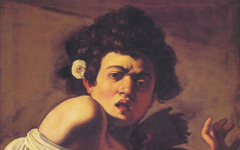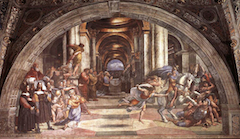Raphael’s Sistine Madonna, Part 1 (1512)
When the Sistine Madonna arrived in Dresden in the 18th century it was the world's most expensive painting and soon became Raphael's best-known masterpiece. It stars Mary and the infant Christ floating above two saints, male and female. One is an early Pope, Sixtus II, who was canonized; the other is St. Barbara. It is a fairly simple, symmetrical composition but has a rich interpretative history based largely on the mystery of the green curtain, an odd detail which doesn't make sense on the surface. Yet seen within an inner-focused self-referential framework, it does.
The conventional view suggests that the two saints are having a vision of the Virgin and Child. The problem is the curtain. Not only is it an inappropriate feature of heaven but the rod sags under the weight of the fabric while Mother and Child nearby float like feathers. 19th-century scholars explained the scene as an exterior view seen from inside a room forgetting that heavily-draped windows were characteristic of their own era not the Renaissance.1 Others maintain that the curtain merely confirms the scene as a vision, a circuitous argument. Is there then a better explanation as to why the curtain is there and why it sags when the holy figures are appropriately weightless? The answer, as so often, is in the painting itself but a little background information can help.
Click next thumbnail to continue

Top: Rembrandt, Holy Family with a Curtain (1646) Oil on canvas. Staatliche Kunstsammlungen, Kassel.
Bottom: Rembrandt, Self-portrait with Mahlstick or as Zuexis (1662) Oil on canvas. Wallraf-Richartz Museum, Cologne.
Click image to enlarge.
One of the best-known stories about painters in antiquity concerns a curtain. Two celebrated artists, Zeuxis and Parrhasius, staged a contest to see who could paint nature most convincingly. Zeuxis painted some grapes so well that real birds flew down to eat them. Thinking he had won, Zeuxis then asked Parrhasius to pull back the curtain covering his own painting. When he discovered that Parrhasius had actually painted the curtain as part of the picture, he admitted defeat.2 Even in the Renaissance, it was not unusual to cover important paintings with a curtain. Later Rembrandt painted one like Zeuxis had done (top) and portrayed himself as Zeuxis too (bottom).3 The curtain then confirms that the scene behind is a painting.
Click next thumbnail to continue
Raphael was even known for depicting the Virgin and Child on their own. The saints then, on a different scale and in a different reality, must be "painters" in the studio. That is why the pope looks over his shoulder to check his models while pointing at (thus, painting) the surface we see. His other hand touches his heart as if to say "I paint inwards." St. Barbara, a woman, mostly does the opposite. She looks down and out with a prominent thumb to suggest a palette-hand. In an illusion, perhaps, she also appears to hold fabric in her hand as if ready to wipe a canvas.4 The two painter-saints symbolize the unity of opposites in Raphael's androgynous mind. Together they look in and out, up and down, with an active brush-hand and a passive palette-one. They also represent the active and contemplative life which is said to be a choice but which, in reality, must be embraced together by those on a spiritual path.5
Click next thumbnail to continue

Left, top and bottom: Details of Raphael's Sistine Madonna (1512)
Right top: Detail of Raphael's Self-portrait (c.1500-02)
Right bottom: Detail of self-portrait from The School of Athens (1509)
Click image to enlarge.
To help confirm the Sistine Madonna's self-referentiality, note how the Virgin resembles Raphael's adolescent self-portrait (top, left & right) while the younger Christ with his blond, flowing hair and large lips, among other features, resembles an older likeness of the artist.
Click next thumbnail to continue
Raphael also formed the holy figures into a giant R for Raphael, a feature I have shown in several other paintings by the artist.6 And yet, as obvious as the R is, it has never to my knowledge been noted in the literature.
I am, nevertheless, not alone in suggesting that a religious work by Raphael is self-referential. Christian Kleinbub proposed that Raphael's last masterpiece, The Transfiguration (c.1520), is also about vision and the creation of art. Yet he believes that Raphael's artistic philosophy is only in that one painting and no other.7 He does not realize that the Sistine Madonna and other works convey similar meaning as do works by other artists too. Art is designed to help us, if we are primed to see it, because we are all poetic painters. We each create our own experience and the path to a successful artwork, the way of the artist, is the way of us all.
As always, there is more to show than I have space for. Here, though, there is another unseen illusion so perfect that it is featured in an addendum.
More Works by Raphael
Notes:
1. Johann Konrad Eberlein, “The Curtain in Raphael’s Sistine Madonna”, Art Bulletin 65, Mar. 1983, p. 62. They may have been influenced by Alberti's 15th-century description of painting as like a view through a window.
2. Pliny, Natural History, Book XXXV. The exact reason why curtains covered paintings is not known. They were not sensitive to light like drawings. It may have been to make a picture's importance obvious and/or to allow the owner to unveil it theatrically to guests.
3. There was also a tradition of deceptive curtain painting in secular Dutch art of the 17th century. Martin Pops, Vermeer: Consciousness and the Chamber of Being (Ann Arbor, MI: UMI Research Press) 1984, p. 5
4. For more on the hundreds of hidden painters in art using a cloth to wipe a canvas, see the EPPH post "Bless you! It's Art".
5. The active and contemplative life is the subject of an earlier work by Raphael, The Dream of Scipio (1502). National Gallery, London. I will be addressing the issue of choosing between the two or embracing both in a paper to be published shortly.
6. See, for example, EPPH entries on Raphael's Expulsion of Heliodorus (1511-12) and La Gravida (1505-06).
7. Christian K. Kleinbub, “Raphael’s Transfiguration as Visio-Devotional Program”, Art Bulletin 90, Sept. 2008, pp. 367-93
Original Publication Date on EPPH: 27 Mar 2014. © Simon Abrahams. Articles on this site are the copyright of Simon Abrahams. To use copyrighted material in print or other media for purposes beyond 'fair use', you must obtain permission from the copyright owner. Websites may link to this page without permission (please do) but may not reproduce the material on their own site without crediting Simon Abrahams and EPPH.






